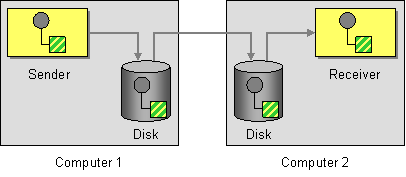Fuse 6 is no longer supported
As of February 2025, Red Hat Fuse 6 is no longer supported. If you are using Fuse 6, please upgrade to Red Hat build of Apache Camel.Este conteúdo não está disponível no idioma selecionado.
6.4. Guaranteed Delivery
Overview
Copiar o linkLink copiado para a área de transferência!
Guaranteed delivery means that once a message is placed into a message channel, the messaging system guarantees that the message will reach its destination, even if parts of the application should fail. In general, messaging systems implement the guaranteed delivery pattern, shown in Figure 6.4, “Guaranteed Delivery Pattern”, by writing messages to persistent storage before attempting to deliver them to their destination.
Figure 6.4. Guaranteed Delivery Pattern
Components that support guaranteed delivery
Copiar o linkLink copiado para a área de transferência!
The following Apache Camel components support the guaranteed delivery pattern:
JMS
Copiar o linkLink copiado para a área de transferência!
In JMS, the
deliveryPersistent query option indicates whether or not persistent storage of messages is enabled. Usually it is unnecessary to set this option, because the default behavior is to enable persistent delivery. To configure all the details of guaranteed delivery, it is necessary to set configuration options on the JMS provider. These details vary, depending on what JMS provider you are using. For example, MQSeries, TibCo, BEA, Sonic, and others, all provide various qualities of service to support guaranteed delivery.
See chapter "JMS" in "Apache Camel Component Reference" for more details.
ActiveMQ
Copiar o linkLink copiado para a área de transferência!
In ActiveMQ, message persistence is enabled by default. From version 5 onwards, ActiveMQ uses the AMQ message store as the default persistence mechanism. There are several different approaches you can use to enabe message persistence in ActiveMQ.
The simplest option (different from Figure 6.4, “Guaranteed Delivery Pattern”) is to enable persistence in a central broker and then connect to that broker using a reliable protocol. After a message is been sent to the central broker, delivery to consumers is guaranteed. For example, in the Apache Camel configuration file,
META-INF/spring/camel-context.xml, you can configure the ActiveMQ component to connect to the central broker using the OpenWire/TCP protocol as follows:
If you prefer to implement an architecture where messages are stored locally before being sent to a remote endpoint (similar to Figure 6.4, “Guaranteed Delivery Pattern”), you do this by instantiating an embedded broker in your Apache Camel application. A simple way to achieve this is to use the ActiveMQ Peer-to-Peer protocol, which implicitly creates an embedded broker to communicate with other peer endpoints. For example, in the
camel-context.xml configuration file, you can configure the ActiveMQ component to connect to all of the peers in group, GroupA, as follows:
Where
broker1 is the broker name of the embedded broker (other peers in the group should use different broker names). One limiting feature of the Peer-to-Peer protocol is that it relies on IP multicast to locate the other peers in its group. This makes it unsuitable for use in wide area networks (and in some local area networks that do not have IP multicast enabled).
A more flexible way to create an embedded broker in the ActiveMQ component is to exploit ActiveMQ's VM protocol, which connects to an embedded broker instance. If a broker of the required name does not already exist, the VM protocol automatically creates one. You can use this mechanism to create an embedded broker with custom configuration. For example:
Where
activemq.xml is an ActiveMQ file which configures the embedded broker instance. Within the ActiveMQ configuration file, you can choose to enable one of the following persistence mechanisms:
- AMQ persistence(the default) — A fast and reliable message store that is native to ActiveMQ. For details, see amqPersistenceAdapter and AMQ Message Store.
- JDBC persistence — Uses JDBC to store messages in any JDBC-compatible database. For details, see jdbcPersistenceAdapter and ActiveMQ Persistence.
- Journal persistence — A fast persistence mechanism that stores messages in a rolling log file. For details, see journalPersistenceAdapter and ActiveMQ Persistence.
- Kaha persistence — A persistence mechanism developed specifically for ActiveMQ. For details, see kahaPersistenceAdapter and ActiveMQ Persistence.
See chapter "ActiveMQ" in "Apache Camel Component Reference" for more details.
ActiveMQ Journal
Copiar o linkLink copiado para a área de transferência!
The ActiveMQ Journal component is optimized for a special use case where multiple, concurrent producers write messages to queues, but there is only one active consumer. Messages are stored in rolling log files and concurrent writes are aggregated to boost efficiency.
